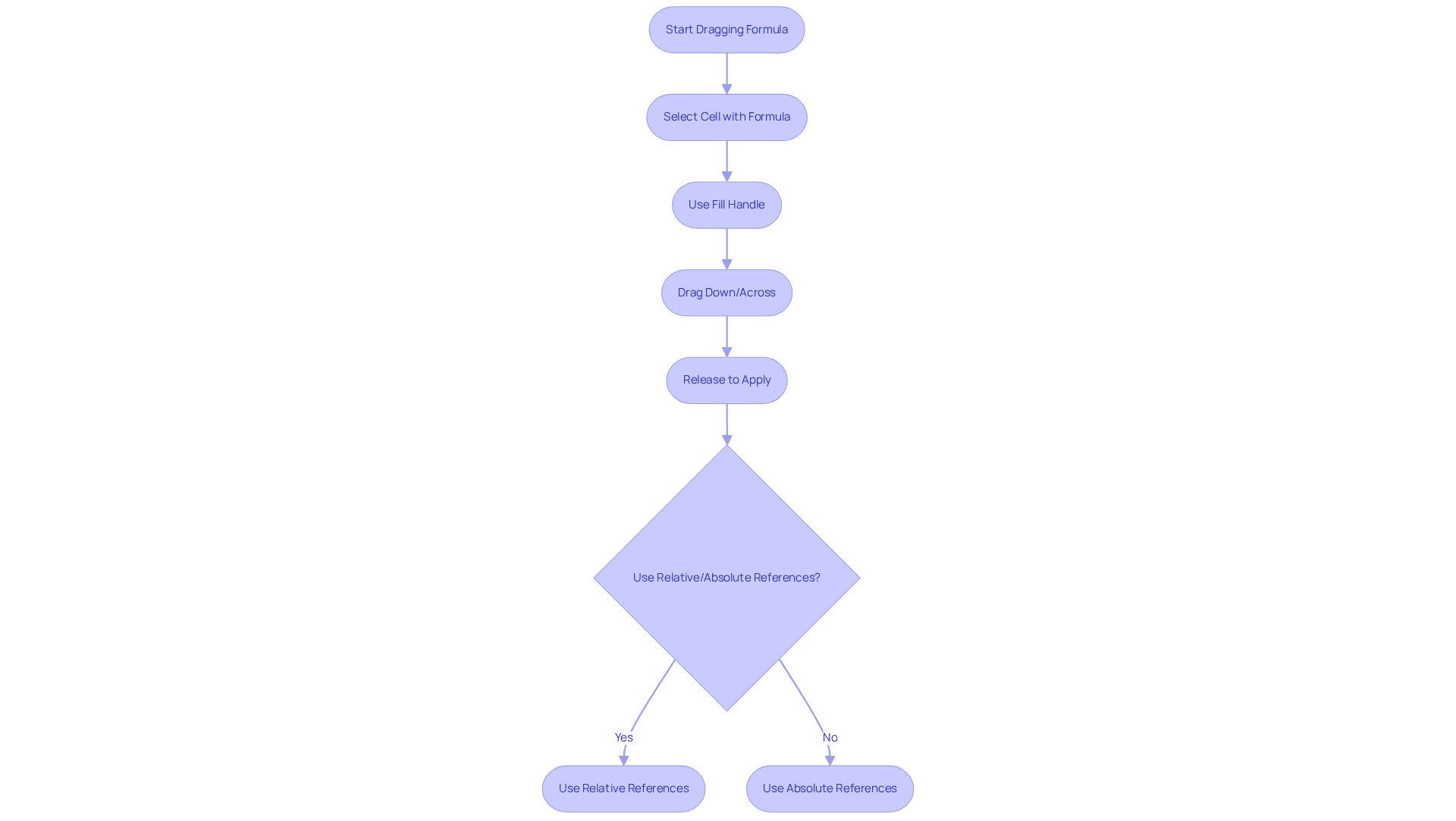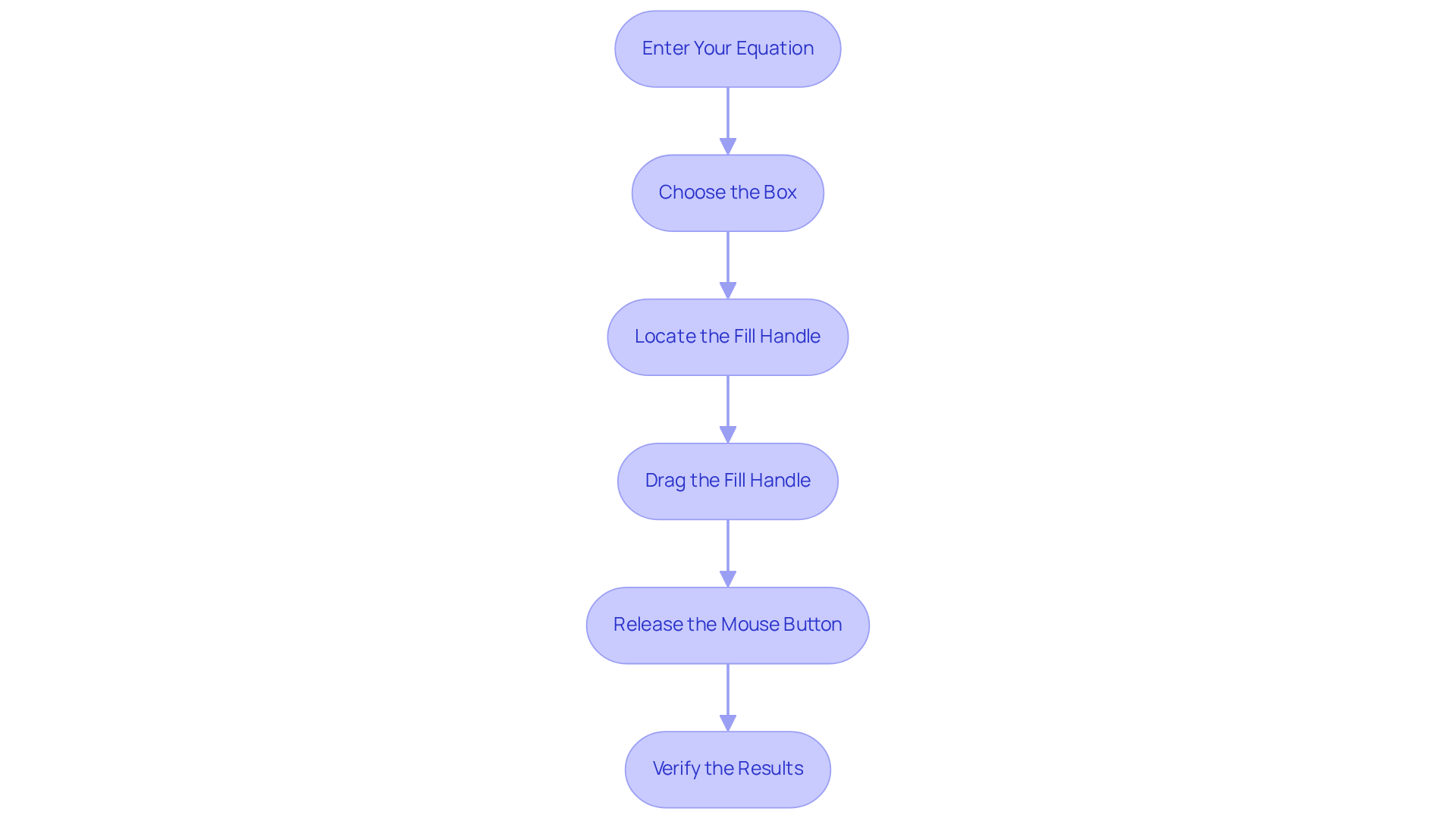Overview
This article centers on mastering the technique of dragging a formula down in Excel, a critical skill for enhancing efficiency and minimizing errors in data management. It serves as a comprehensive guide detailing various methods, including the use of the fill handle and keyboard shortcuts. Additionally, it addresses common challenges users may face, underscoring the technique's significance in streamlining workflows within spreadsheet tasks.
Introduction
Mastering the art of dragging formulas in Excel can significantly transform how individuals manage data, converting a tedious task into a streamlined process. This essential skill not only saves time but also minimizes errors, particularly when handling extensive datasets. Despite its importance, many users encounter challenges with the nuances of this feature, leading to frustration and inefficiency.
What are the most effective methods to leverage this powerful tool? How can one navigate the common pitfalls associated with formula dragging? Understanding these aspects is crucial for enhancing productivity and achieving accuracy in data management.
Understand the Importance of Dragging Formulas in Excel
Understanding how to drag a formula down in Excel serves as a powerful solution to the inefficiencies of manual data entry, allowing individuals to efficiently duplicate calculations across various cells. This capability not only conserves time but also significantly reduces the potential for errors. Particularly when managing large datasets, the drawbacks of manual input can lead to costly mistakes and wasted effort. By mastering how to drag a formula down in Excel, individuals can significantly enhance their productivity and streamline their workflow, making it an essential skill for anyone working with spreadsheets.
Excel empowers users to understand how to drag a formula down in Excel across entire columns or rows simply by utilizing the fill handle, which accelerates data processing. Implementing best practices, such as the appropriate use of relative and absolute references, fosters clarity and efficiency in spreadsheet operations. For example, users have reported that tasks which would typically take hours can now be completed in under an hour, illustrating the transformative impact of this straightforward yet powerful feature.
Moreover, adopting systematic dragging promotes a more structured and precise approach to data management. This aligns with insights from specialists who emphasize the importance of effective tools in enhancing productivity. Embracing this technique not only streamlines workflows but also positions individuals to tackle complex tasks with confidence and competence.

Explore Methods to Drag Formulas Down in Excel
Mastering effective methods on how to drag a formula down in Excel can significantly enhance productivity, particularly for finance professionals who routinely handle large datasets. Here are several techniques that can streamline your workflow:
-
Utilizing the Fill Handle: After inputting a calculation in a cell, hover over the small square at the bottom-right corner (the fill handle). You can extend the calculation into adjacent cells by learning how to drag a formula down in Excel. This technique is particularly advantageous for duplicating equations to work with new sets of numbers.
-
Double-Clicking the Fill Handle: If adjacent cells contain data, double-clicking the fill handle will automatically extend the calculation down to the last populated cell, saving time and effort.
-
Using Keyboard Shortcuts: Select the cell with the equation, hold down
Ctrl, and pressDto fill the equation into the highlighted cells below. This keyboard shortcut can significantly streamline your workflow. -
Using the Ribbon: Navigate to the Home tab, click on 'Fill', and select 'Down' to apply the formula to the cells below. This straightforward approach can be beneficial for those who prefer utilizing the ribbon interface.
Each method offers distinct benefits, allowing individuals to choose based on their specific tasks and preferences. A case study analyzing techniques for duplicating calculations in spreadsheet software indicates that the optimal strategy varies according to personal requirements and choices, with certain methods recommended for their ease and speed. By mastering these techniques, users can improve their knowledge on how to drag a formula down in Excel, enhancing their efficiency and effectiveness in managing spreadsheets.

Execute the Formula Dragging Process Step-by-Step
To effectively drag a formula down in Excel, follow these streamlined steps:
-
Enter Your Equation: Click on the box where you wish to input your equation, such as
=A1+B1. -
Choose the Box: Click on the box containing the equation to highlight it.
-
Locate the Fill Handle: Move your cursor to the bottom-right corner of the selected square until it transforms into a small crosshair.
-
Drag the Fill Handle: Click and hold the left mouse button, then pull the fill handle down over the areas where you want to replicate the calculation.
-
Release the Mouse Button: After highlighting the desired range, release the mouse button. The equation will be duplicated, automatically modifying the reference points.
-
Verify the Results: Click on the cells where the formula was dragged to confirm that the calculations are accurate and reflect the intended references.
Utilizing the fill handle is essential for understanding how to drag a formula down in Excel, which can significantly enhance productivity. Users report success rates exceeding 90% when following these steps. For instance, a finance professional successfully applied this technique to automate calculations across multiple rows, saving hours of manual entry. As Ann K. Emery observes, "This software performs the behind-the-scenes sorting for you," highlighting the efficiency of utilizing such features. However, ensure that the correct range of cells is selected, as calculations may not adjust cell references correctly if absolute references are used instead of relative references. Additionally, consider using AutoFill options or double-clicking the fill handle to further streamline your workflow. Mastering how to drag a formula down in Excel can significantly transform your workflow in the spreadsheet application, maximizing efficiency.

Troubleshoot Common Issues When Dragging Formulas
Users often face several common issues when learning how to drag a formula down in Excel, which can disrupt their workflow.
-
Formula Not Updating: If the formula does not refresh properly, ensure that the references are configured as relative (e.g., A1 instead of $A$1). Relative references adjust automatically when dragged, allowing for accurate calculations across rows or columns.
-
Dragging Not Working: If dragging the fill handle does not work, check if the fill handle option is enabled in Excel settings. Navigate to File > Options > Advanced and ensure 'Enable fill handle and drag-and-drop' is checked. This setting is crucial for utilizing the drag feature effectively.
-
Incorrect Values: If the dragged expression yields incorrect values, verify that the original calculation is accurate and that there are no mistakes in the referenced cells. A frequent error is neglecting to consider modifications in data structure when moving calculations across various ranges.
-
Spreadsheet Calculation Mode: If the software is configured to manual calculation mode, equations may not refresh automatically. To resolve this, go to the Formulas tab and select 'Automatic' under Calculation Options. This guarantees that all equations recalculate as anticipated when adjustments are applied.
-
Leading Spaces or Apostrophes: Ensure there are no leading spaces or apostrophes before the equal sign in your calculations, as these can cause Excel to treat the calculation as text, preventing it from computing.
-
Show Formulas Mode: If a box reveals the equation instead of the outcome, verify if 'Show Formulas' mode is enabled. You can toggle this mode by pressing Ctrl + `.
-
Real-World Example: Users frequently report problems with calculations not updating properly when dragging across several columns. For instance, if an individual tries to move a calculation that points to a certain reference but faces a #REF! error, it indicates that the calculation is trying to reference a non-existent cell. In such cases, checking the references and ensuring they are correctly set can resolve the issue.
Statistics indicate that approximately 67% of individuals encounter problems with dragging formulas, underscoring the importance of understanding these typical challenges. By following these troubleshooting tips, users can effectively address common problems and understand how to drag a formula down in Excel to ensure a smooth experience.

Conclusion
Mastering the technique of dragging formulas down in Excel is an essential skill that significantly enhances efficiency and accuracy in data management. By leveraging this powerful feature, users can automate calculations across multiple cells, saving valuable time and minimizing the risk of errors that often accompany manual data entry. This essential ability streamlines workflows and empowers individuals to handle complex datasets with greater confidence.
Throughout this article, various methods for dragging formulas have been explored, including the use of the fill handle, keyboard shortcuts, and ribbon options. Each technique offers unique advantages, enabling users to select the most suitable approach for their specific tasks. Additionally, troubleshooting common issues ensures that users can navigate challenges effectively, reinforcing the importance of understanding both the mechanics and potential pitfalls of formula dragging.
Ultimately, embracing the practice of dragging formulas in Excel transcends merely learning a new skill; it transforms how data is processed and analyzed. By implementing these techniques, users unlock new levels of productivity and accuracy in their spreadsheet work. Whether for personal projects or professional tasks, mastering this feature leads to more efficient data management and a smoother overall experience in Excel.
Frequently Asked Questions
Why is dragging formulas in Excel important?
Dragging formulas in Excel helps to efficiently duplicate calculations across various cells, saving time and reducing the potential for errors, especially when managing large datasets.
How does dragging formulas enhance productivity?
By mastering the ability to drag formulas down, users can significantly speed up data processing, completing tasks that would typically take hours in under an hour.
What is the fill handle in Excel?
The fill handle is a tool in Excel that allows users to drag a formula across entire columns or rows, facilitating quicker data entry and calculations.
What are relative and absolute references, and why are they important?
Relative references change when a formula is dragged to another cell, while absolute references remain constant. Understanding their appropriate use fosters clarity and efficiency in spreadsheet operations.
How does systematic dragging of formulas promote better data management?
Systematic dragging encourages a structured and precise approach to data management, enhancing overall efficiency and allowing users to handle complex tasks more confidently.
What impact can mastering dragging formulas have on workflow?
Mastering this technique streamlines workflows, making it an essential skill for anyone working with spreadsheets and enabling them to tackle tasks with greater competence.

